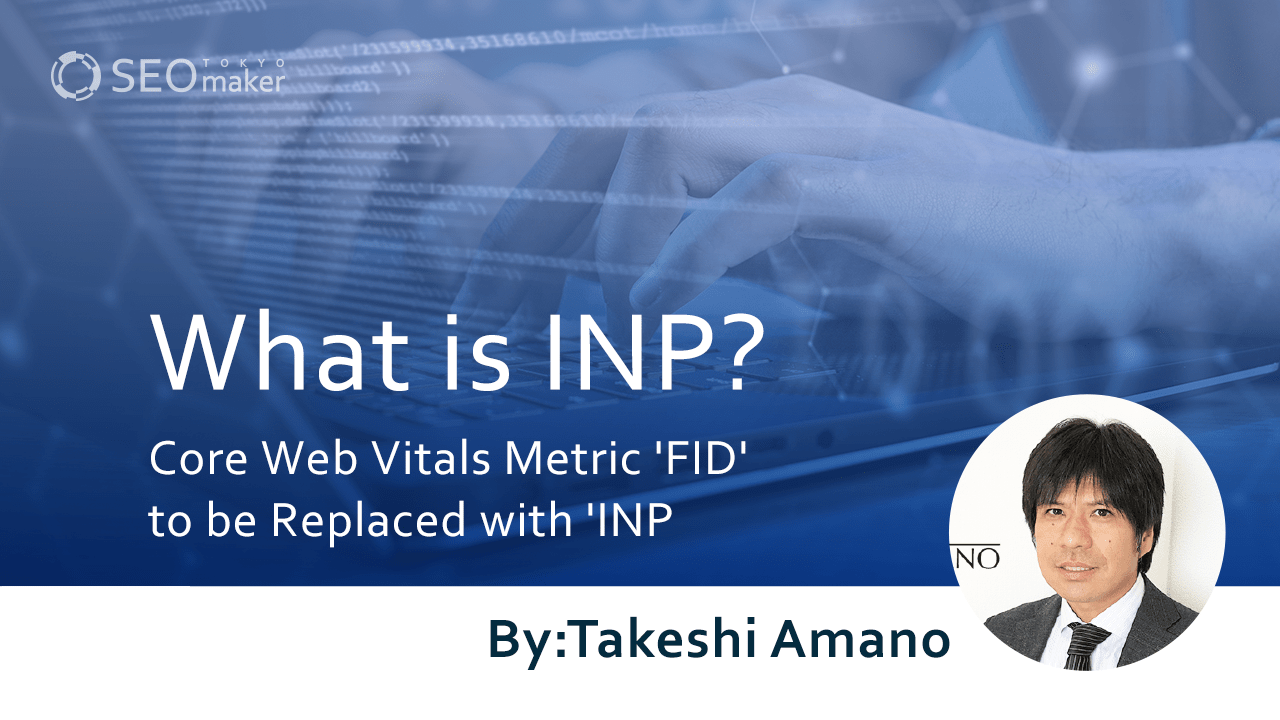What is INP? Core Web Vitals Metric ‘FID’ to Change to ‘INP’
contents
 It has been announced on the Google Search Central Blog that the FID, a key metric of Core Web Vitals, will be replaced by a new metric, INP.
It has been announced on the Google Search Central Blog that the FID, a key metric of Core Web Vitals, will be replaced by a new metric, INP.
Core Web Vitals are crucial for SEO strategies as they are one of the key factors determining Google’s search engine algorithms.
With the transition of FID to INP in Core Web Vitals, even web pages currently rated highly might experience a change in their evaluations.
As SEO consultants, Tokyo SEO Maker, a specialist in SEO media, will explain the new metric, INP. We will focus on the differences between FID and INP and compile strategies that website operators should consider implementing.
About INP
Interaction to Next Paint (INP) is a new metric replacing First Input Delay (FID) in Core Web Vitals. Scheduled for official implementation in March 2024, INP is a comprehensive measure of a webpage’s responsiveness to user interactions. According to the web development information site web.dev, INP measures latency across all user interactions during a page visit, including clicks, taps, and keyboard operations. The final INP value is based on the longest detected interaction, excluding outliers. Essentially, INP expands the measurement scope beyond FID, offering a more reliable metric.
Core Web Vitals and FID
Core Web Vitals are a set of three metrics designed to measure the quality of user experience on web pages. These include:
- LCP (Largest Contentful Paint): Measures page loading speed.
- FID (First Input Delay): Measures the speed at which a page responds to user actions.
- CLS (Cumulative Layout Shift): Assesses the stability of the page layout.
Among these, FID is being updated to INP (Interaction to Next Paint). FID specifically measures the time it takes for a page to respond to user interactions, such as the time between clicking a link or entering text in a comment form and the page responding to these actions.
Reasons and Background for Google’s Implementation of INP
Google believes that providing an exceptional experience to users is essential for web pages. Thus, in June 2021, the company integrated Core Web Vitals, a set of metrics indicative of user experience, into its search algorithm.
However, there were measurement limitations associated with First Input Delay (FID), one of the Core Web Vitals metrics. These limitations posed practical challenges in assessing user experience.
Limitations of FID in Excluding Event Handler Processing
FID, or First Input Delay, has limitations in its measurement criteria. Notably, it does not include the execution time of internal processes known as Event Handlers. Additionally, the time it takes for the rendering to start on the browser screen is also not included in FID measurements.
For example, consider a scenario where a site visitor’s action triggers the display of a popup. However, the waiting time until the visitor visually perceives the popup on the browser is not accounted for in FID.
Due to these reasons, some website operators focusing on SEO optimization have prioritized improvements only in the initial response, a scope covered by FID. This approach has led to a divergence from pursuing realistic user experiences.
In response, Google aimed to refine Core Web Vitals to yield more practical measurement data. This led to the introduction of INP, which includes the waiting time until the start of browser rendering.
Differences Between INP and FID
The differences between INP (Interaction to Next Paint) and FID (First Input Delay) are as follows:
| Metric | FID | INP |
| Measurement Target | First action upon page visit | All actions during page stay |
| Measurement Duration | Time until page processing starts | Time until response starts |
INP measures the overall responsiveness of a page to all actions during a user’s stay. This allows for the collection of more reliable data compared to traditional measurement methods.
The specific measurement criteria for FID and INP are as follows:
- FID Measurement Criteria: FID focuses on the first input or interaction a user makes upon visiting a page. It measures the time from the user’s first interaction to the time the browser begins to process that interaction.
- INP Measurement Criteria: INP, on the other hand, extends beyond the first interaction. It measures the responsiveness of the page throughout the user’s entire visit, encompassing all interactions and their corresponding response times.
By adopting INP, a more comprehensive and realistic understanding of user experience is achieved, enhancing the effectiveness of performance analysis and optimization strategies for websites.
FID Measurement Targets
In traditional FID (First Input Delay), the focus is on measuring only the waiting time from the first interaction made by a site visitor to the start of page processing. This waiting time is referred to as input delay time.
Targets of INP Measurement
INP (Interaction to Next Paint) measures the page’s response speed to all actions of a site visitor. Among these, the most delayed measurement data is selected as the INP.
In addition to measuring the waiting time until page processing begins, INP also measures the time taken from the start of processing to the start of rendering. Thus, INP includes three phases: input delay time (similar to FID), processing delay time for code execution, and display delay time for browser rendering.
Importance and Evaluation Criteria of INP
INP, like FID, has set target values that should be met. These criteria are specified as follows:
| Evaluation Criteria | Target Value for INP |
| Good | Less than 0.2 seconds |
| Needs Improvement | Longer than 0.2 seconds, but less than 0.5 seconds |
| Poor | More than 0.5 seconds |
According to the Chrome User Experience Report (Chrome UX / CrUX), among popular pages, 99.9% on desktop and 93.6% on mobile are rated as good in terms of FID. CrUX is a dataset of user experience data aggregated from browsers worldwide, indicating that most popular web pages do not have issues with FID.
However, the same report shows that as of 2023, while 96.8% of popular pages on desktop are rated good for INP, only 64.9% achieve this on mobile, indicating nearly half of the pages have issues in mobile INP.
This implies that websites ranking high on Google search engines and performing well in FID may not necessarily be rated sufficiently in terms of INP.
Measuring INP for SEO Optimization
Websites optimized for SEO should prepare for the implementation of INP (Interaction to Next Paint) by March 2024. To check the INP of a website, SEO tools like Google Search Console and PageSpeed Insights can be used.
Checking INP with Google Search Console Google Search Console, a site analysis tool provided by Google for web operators, can be utilized to check a website’s INP.
Here’s how to check INP using Google Search Console:
- Access and log in to Google Search Console.
- Click on “Core Web Vitals” under the “Experience” menu.
- Select the report for Mobile or Desktop.
- Check the INP for your site.
As of 2023, following these steps in Google Search Console, you can find a section titled “Preparing for the upcoming changes in March 2024,” where the INP of your site’s pages can be reviewed.
Checking INP with PageSpeed Insights
PageSpeed Insights, a tool for measuring the loading speed of web pages, can be used to check the INP (Interaction to Next Paint) of a specific URL.
How to Use PageSpeed Insights to Check INP:
- Access PageSpeed Insights: Navigate to the PageSpeed Insights service website. This tool can be used without logging into a Google account.
- Enter the URL for Analysis: Simply enter the URL of the page you want to analyze in the provided field.
- Click ‘Analyze’: After entering the URL, click on the ‘Analyze’ button to start the evaluation.
- Check the INP: Once the analysis is complete, PageSpeed Insights will display various metrics, including INP, for the specified page.
The section highlighted in the image data shows the INP. For instance, in the provided example, while the FID is 0.016 seconds, meeting the evaluation criteria, the INP is 0.517 seconds, which does not meet the set standard. This discrepancy highlights the importance of not only focusing on FID but also on INP for a comprehensive assessment of a webpage’s performance.
Improving INP (Interaction to Next Paint)
If you identify a web page with issues in INP, improvements are necessary. The key elements that contribute to a low INP score are:
- Input Delay Time
- Processing Delay Time
- Display Delay Time
Input Delay Time
Improving input delay time involves strategies similar to optimizing FID, as it measures the duration from a site visitor’s action to the start of internal processing. Key methods include reducing unnecessary JavaScript and implementing deferred loading for JavaScript.
Processing Delay Time
Processing delay time refers to the duration taken to process code. Specifically, optimizing time-consuming internal processes can help shorten processing delay time. This can be achieved by:
- Dividing long-running tasks into smaller parts.
- Avoiding layout thrashing (forced synchronous layouts).
Display Delay Time
Improving Display Delay Time
Display delay time is the period between the completion of code processing and the start of visual changes on the browser. To improve this time, the following methods can be employed:
- Reducing the Size of the DOM: A smaller DOM size can accelerate rendering as there are fewer elements for the browser to process.
- Using the ‘content-visibility’ Property: This CSS property allows you to control the rendering of off-screen content, which can significantly improve rendering performance.
- Optimizing HTML Rendering with JavaScript: Efficiently managing how JavaScript manipulates the DOM and renders HTML can reduce the time until visual changes are displayed.
- Frequently Asked Questions about INP
- Here’s a FAQ-style introduction to common questions about INP (Interaction to Next Paint):
- Q: What does INP mean? A: INP stands for Interaction to Next Paint, representing the responsiveness of the browser until rendering begins. For example, consider a visitor clicking an image enlargement button on a web page. The wait time until the image popup is rendered on the browser is quantified as INP. INP is introduced as a replacement for FID in Core Web Vitals.
- Q: When will INP be introduced? A: INP is scheduled to be integrated into the Google search engine in March 2024.
- Q: Does INP affect SEO? A: Yes, INP is treated as one of the factors determining search rankings in Google’s search engine. Therefore, improving INP can have a positive impact on SEO.
- Q: What is the passing criterion for INP? A: A web page’s INP is considered ‘Good’ (the highest rating) if it is below 200ms (0.2 seconds).
- Q: If a website is optimized for FID, is it necessary to also optimize for INP? A: Yes, INP optimization is necessary even if a site is already optimized for FID. While FID measures the waiting time from a user’s action to the start of internal processing, INP additionally includes processing delay time and display delay time. Even if there are no issues with the input waiting time covered by FID, there might be potential problems with processing and display delay times that need to be addressed.
Summary
In March 2024, FID (First Input Delay), a key metric of Core Web Vitals, will be replaced by INP (Interaction to Next Paint). INP expands the measurement scope compared to FID, assessing not only the input delay but also processing and display delays. It’s noteworthy that even web pages rated ‘Good’ (良好) under FID may not meet the same standard in INP. To ensure comprehensive SEO optimization, it is crucial to measure your website’s INP. If issues are identified, appropriate improvement strategies should be implemented to enhance overall performance and user experience. This transition highlights the evolving nature of web performance metrics and the need for continual adaptation in SEO strategies.










![What is a Description? Explaining the Meaning, Writing Style, and Changing Word Count – [2023 Edition]](https://www.switchitmaker2.com/en/wp-content/uploads/2024/09/what-is-description.webp)










